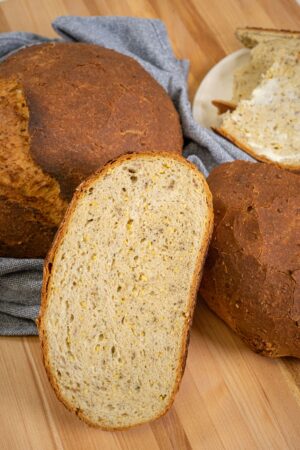
Boosting protein in baking
By Jane Dummer
Food Trends Bake & Snack Food Health & Wellness Ingredients & Additives Avena Foods Editor pick The Protein BreweryCompanies are offering protein-rich ingredients to enhance nutrition while improving eating experiences with baked goods
 Pulse-based ingredients can be used to replace eggs in conventional and gluten-free baked goods. Photos © Avena Foods
Pulse-based ingredients can be used to replace eggs in conventional and gluten-free baked goods. Photos © Avena Foods Achieving desirable tastes and textures in baked goods can be challenging when formulators want to enhance the protein content. Earlier this year in Chicago, at BakingTECH 2023, the theme of fortifying with plant-based proteins was trending on the exhibit floor and during the sessions and panels. At the event, I discovered a new company, the Protein Brewery, and a longstanding favourite, Avena Foods. Both are actively working in the space of enhancing nutrition through protein-rich ingredients while delivering improved eating experiences in baked goods and breads.
Enhancing nutrition
This is excellent news as consumers consider nutrition more than ever. Plus, consumers are showing a special interest in protein. Specifically, alternatives to animal-based proteins, in all categories including baking. This presents an opportunity for ingredients including pulses, ancient grains like sorghum and seeds such as chia, as well as new whole food, neutral-flavoured ingredients.
Pulse-based ingredients, specialty-milled from beans, chickpeas, and lentils, are used in conventional and gluten-free baked goods to replace both dried and fresh eggs and egg whites.
“They increase the protein quality and content in conventional and gluten-free baked goods. These whole ingredients have a mild flavour and are naturally high in protein, delivering a clear and clean vegan label option,” says Margaret Hughes, vice-president sales and marketing, Avena Foods.
She adds that PDCAAS (protein digestibility score) can be improved when pulse flours, specialty-milled or native, are blended with wheat, oat, or other grain flours.
Lanier Dabruzzi, director of nutrition and food innovation, United Sorghum Checkoff Program, describes, “Sorghum flour is a wonderful high-protein gluten-free option for the baking industry. Whole grain sorghum provides nearly 30 per cent of the daily value (DV) of protein, but it doesn’t stop there. Unlike some other gluten-free flours, whole grain sorghum flour provides a robust nutrition profile. It is an excellent source of 12 essential nutrients, including protein, fibre, iron, and many others.”
Sandra Gillot, CEO, Benexia, explains, “When formulating high-protein bakery products, the goal is to achieve increased protein in the same portion size as the traditional version. Chia flour contains up to 100 per cent more protein than most cereal starch flour used in traditional bakery, providing more protein in quantity (g per serving) as well as quality. Chia flour brings not only high-quality protein and fibre, but is also an excellent source of essential fat omega-3 alpha-linolenic acid (ALA).”
The Protein Brewery uses biomass fermentation to create a plant-based whole protein ingredient. “It is a non-sterile process combined with a proprietary fungi strain that converts water efficient crop side streams, such as potato or corn (golden remains), into a high-quality protein (PDCAAS = 1.0 or 100 per cent), insoluble dietary fibre, essential fatty acids, vitamins and minerals,” explains Deb Anderson, director of new business development, the Protein Brewery.

Pulse grits increase the visual appeal and texture of gluten-free breads.
Improved functional outcomes
Distributing protein-rich ingredients throughout the baking formulation can increase overall nutrition and functionality, while improving the appearance, texture, and taste of the final product. There are specific considerations for vegan and gluten-free options. Often eggs are a vital ingredient for emulsifying and structure. This presents an opportunity for egg-free formulations. For gluten-free, it’s all about maintaining structural integrity while delivering an appealing mouthfeel.
Avena has a whole line of pulse-based ingredients that can replace, fully or partially, eggs in conventional cakes, cookies, muffins, pancakes, waffles, doughnuts, and brioche buns as well as some starches in gluten-free applications, including bread, muffins, brownies, and pizza crusts.
“Cracked pulses and pulse grits are whole pulse ingredients that add visual appeal and texture while increasing the protein content of baked goods. These natural ingredients don’t require prehydration and work in blends with grains and seeds,” says Hughes.
Sorghum is neutral in flavour and colour, making it a versatile option in gluten-free formulations. Dabruzzi explains, “Sorghum has a unique grain matrix when looking at the protein and carbohydrate interlinkages. The protein and carbohydrate molecules are packed extremely tightly within the sorghum grain, which results in the proteins protecting the carbohydrates from retrogradation or drying out. Due to this matrix, baked goods using sorghum flour retain moisture longer than those using other types of flours.”
Remi Reguero, technical director, Benexia, says, “When formulating gluten-free, high protein products, everything becomes more complex as gluten is the functional protein source in traditional baked goods. Therefore, formulators must use substances like hydrocolloids to mimic classic product textures. A common hydrocolloid used in gluten-free bakery is xanthan gum. The fact that chia flour has a soluble fibre content like xanthan gum makes it an excellent choice for gluten-free, high-protein and clean label applications.”
This column was originally published in the October 2023 issue of Food in Canada.
Print this page